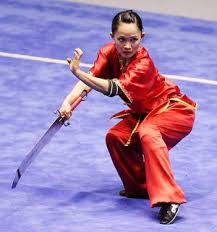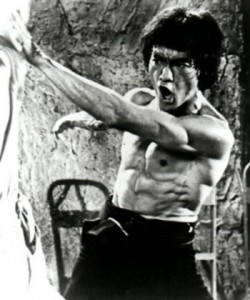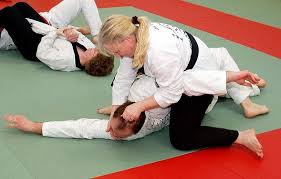Taijutsu
 Taijutsu is a Japanese melee system without the use of weapons, as well as the art of maintaining a healthy body.
Taijutsu is a Japanese melee system without the use of weapons, as well as the art of maintaining a healthy body.
Taijutsu consists of almost all the techniques used: limbs, twists, throws, chokes, etc., this art embodies the traditions of the millennium-long development of the special art of the shadow warrior. This art considers the main goal to develop consciousness, the spirit of a fighter through the comprehension of military equipment and special mental practices.
During the fight of high-level masters, the smallest movement can decide the fight, give the strongest victory in the hands. If the technique is nearly perfect, one minimal inaccuracy of movement sometimes determines life or death. Taijutsu is a “body technique”; no weapons are used in this style.
Chikara-kurabe and sumai
In ancient times, the struggle in Japan was quite primitive and was carried out in the form of competitions to measure strength. It was strength, and not other features of the fighter – technique, agility – that determined the winner. In the 5-6 centuries. On the basis of the tikara-kurabe struggle, a popular sumo wrestling was formed, and to be precise, its initial version is sumai. During the Nara period, sumai was widespread.
The technique of the ancient sumo was primitive and consisted of shocks, knocks, blockages. Wrestlers maximized their weight with a special diet. In competitions, strikes were banned due to their particular danger, but in real battles wrestlers often used punches and heel strikes forward. The victory in the ritual duel was awarded to the wrestler who threw the opponent to the ground, so the fight on the ground was not applied.
Chinese martial arts in Japan
Taijutsu in the 8th-9th centuries Japan’s interaction with the mainland intensified. A huge stream of immigrants with their culture and traditions poured from China and Korea into the Land of the Rising Sun. Immigrants brought local original methods of warfare, in which the main techniques were punches and kicks, painful techniques. Interesting that existed in the 12-14 centuries. the semi-legendary school of shosho-ryu (“school of all awards”), the founder of which is considered to be a commander from a noble Chinese family Sakanoue Tamuramaro, who became famous for his many victories. A feature of this school was the development of particularly powerful hand strength and hardening of impact surfaces, which, according to legend, made it possible to break through a steel shell. From unidentified sources, it is known that the invincible military leader Minamoto Yoshitsune was shocked to see the work of the Shosho-ryu master.
The Tsoshui-ryu school founded by Otomo Komaro in the 8th century left a big mark in the history of Japanese martial arts. Later, in the mid-14th century, the samurai of Urabe no Sukune Kanesada improved her technique and added the techniques of the Chinese master Sunzhen Ishu. The fighting technique of Choshui-ryu formed the basis of Kuki Shinden-ryu – one of the most significant schools of Japanese bujutsu.
Yoroi-kumiuti
Since the 10th century, along with the formation of the samurai class, a special system of struggle in armor, the Yoroi-Kumiuti, began to form.
In many ways, it was like a sumo on the application of shocks and stalls, because the fighters in the battles were in armor, and the total weight of the fighter with the armor was comparable to the artificially obtained weight of the sumoist. Inconvenient, box-like shells prevented anyone from taking a comfortable grip. However, the Yoroi-kumiuti technique was much richer in sumo: it had no conditional restrictions to wage a fight while standing, not to fall to the ground, not to use blows and weapons. The soldiers could use any tricks and methods, just to achieve results.
Yoroi-kumiuti techniques were used if a warrior lost his weapon — dropped, broke, etc. In battles of the 10th-13th centuries, the battle began with mutual archery, then an attack followed and the enemies found themselves on the ground. It was difficult to use the sword in such conditions – there was no time to even get it out of the scabbard. In connection with this, Yoroi-kumiuti was at that time more popular than fencing with big swords. A short sword or dagger-tanto was very popular at that time and was used in the style of yoroi-kumiuti.
The base of the yoroi-kumiuti was made up of various tricks – captures, throws, strangulation, which helped to fight with an armed opponent in armor. If possible, warriors could use punches and kicks, but only in addition – it was easier to injure a limb about armor than to damage a warrior in it.
The main thing in the uroi-kumiuti was the correct use of the hips and limbs, which was achieved by the special symmetrical capture of the yotsu-gumi – the “quadruple grip”. In such a capture, the soldiers grabbed each other without touching the armor plate. Etsu-gumi helped the warrior maintain balance and mobility, and made it possible to control the enemy.
Both or one fighter at any second were ready to get a short sword or dagger for piercing armor – Yoroi-dosi. This dagger was worn behind the belt on the thigh on the right, reaching with his left hand. Special skills were needed to hold the enemy with one hand, maintain balance, while with the second hand it was tedious to get a dagger and try to hit the part of the enemy’s body that was not covered with armor.




